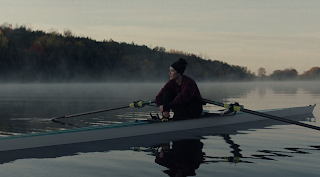 |
| Winston Duke and Zazie Beetz in "Nine Days" Photo Credit: RottenTomatoes.com |
1) “Nine Days” - An understated, yet bold filmmaking debut from this year was writer-director Edson Oda’s meditative supernatural drama, which follows a man named Will (Winston Duke), who interviews five unborn souls to see which one will be given the chance for a life on Earth. Duke provides a beautiful performance as a man who must make tough decisions of who gets the sought-after opportunity. While all of the supporting performances are terrific, the standouts are two of the souls, played by Zazie Beetz as the kind, inquisitive Emma, and David Rysdahl as the soft-spoken Mike, both of whom offer windows into their minds and allow us to see the many thoughts that percolate within them as they go through this emotional process. Oda’s screenplay is a layered, contemplative story that examines life from a fascinating angle, providing us with a poignant look at how each of the characters views this valuable opportunity. Through Oda’s direction, he allows us to sit and take in the power that he extracts from each of the character interactions, all while he constructs an otherworldly environment befitting to a premise that’s loaded with originality. In a movie that’s asks some powerful questions about life, this is a story that brims with it.
 |
| Stephanie Beatriz in "Encanto" Photo Credit: Imdb.com |
2. “Encanto” - This year, Disney’s animated films have invited us on cross-cultural excursions through Southeast Asia in “Raya and the Last Dragon” and the Italian coast in “Luca.” Now, they whisk us away to the lush lands of Columbia in their latest movie, “Encanto.” The film tells the story of Mirabel Madrigal (Stephanie Beatriz), a young woman who lives with her family in a magical home where everyone has a superhuman ability, except her. When the magic of their family is threatened, it’s up to Mirabel to find a way save it. The voice cast has a vibrancy throughout, especially Beatriz and John Leguizamo as Mirbael’s cousin, Bruno. Although the screenplay is a little rushed near the ending, it subverts the expectations of the traditional Disney hero/heroine story, with the journey being less a physical journey then it is an emotional one. As for the music, while a couple of the songs aren’t too memorable, there are some standouts, such as the opening number, “The Family Madrigal,” and the emotional “Dos Oruguitas.” Directors Jared Bush and Byron Howard provide a movie that continues Disney’s tradition of bringing us to gorgeous settings that show how far animation has grown. This ensures that, despite a couple of flaws, “Encanto” will still find a way to leave you enchanted.
 |
| Isabelle Fuhrman in "The Novice" Photo Credit: RottenTomatoes.com |
3. “The Novice” - When it comes to movies like Darren Aronofsky’s “Black Swan” or Damien Chazelle’s “Whiplash,” we know that it’s always a tense experience when you watch a movie that focuses on the main character striving for perfection and the addiction into which it can morph. Such is the case with writer-director Lauren Hadaway’s filmmaking debut. The story follows Alex Dall (Isabelle Fuhrman), a college freshman who joins her school’s rowing team, only to become obsessed with being the best. Fuhrman delivers a profound performance of a young woman who puts herself through the physical and psychological wringer to place herself above everyone else. For a character who shows a full, yet unsettling commitment to her goals, Fuhrman shows the fullest commitment to inhabiting this character and her questionable ideals. Despite some heavy-handed symbolism in spots, the screenplay’s central message is still impactful as we see the dangerous degree to which Alex dedicates herself to reaching her goal, showing a character who’s her own worst enemy. Hadaway delivers exhausting workout sequences and rowing scenes, bringing us through moments of blood, sweat, tears, and blisters, always having you wonder what Alex will lose as she strives for what she wishes to gain.
 |
| Riz Ahmed in "Mogul Mowgli" Photo Credit: RottenTomatoes.com |
4. “Mogul Mowgli” - One of the most superb and new dramatic visions of the year comes from director, Bassam Tariq. In his film, we follow Zed (Riz Ahmed) a British-Pakistani rapper who’s career is on the rise. When he’s diagnosed with a degenerative autoimmune disease, he returns to London to see his family. Ahmed, who cowrote the screenplay with Tariq, provides hard-hitting work as an artist who boasts a commanding energy when performing, but then must go through a heartbreaking shift when faced with restricted movement. Given how Ahmed stared in Darius Marder’s “Sound of Metal” last year, in which he played a drummer who faces progressive hearing loss, Tariq’s film serves as a fine companion piece, with these being two films concerning artists who encounter intense hardships that hinder their ability to create. Through occasional dreamlike imagery, a couple of electric concert sequences, and scenes of Zed dealing with his family and the possibility of never being able to perform again, the film has to cover quite a bit in just 90 minutes, but succeeds. Through this, you’ll come away from the movie feeling as if you experienced a full view into the main character’s life, both with what he faces in the present, and what he has faced in his past.














